What's In A Name?
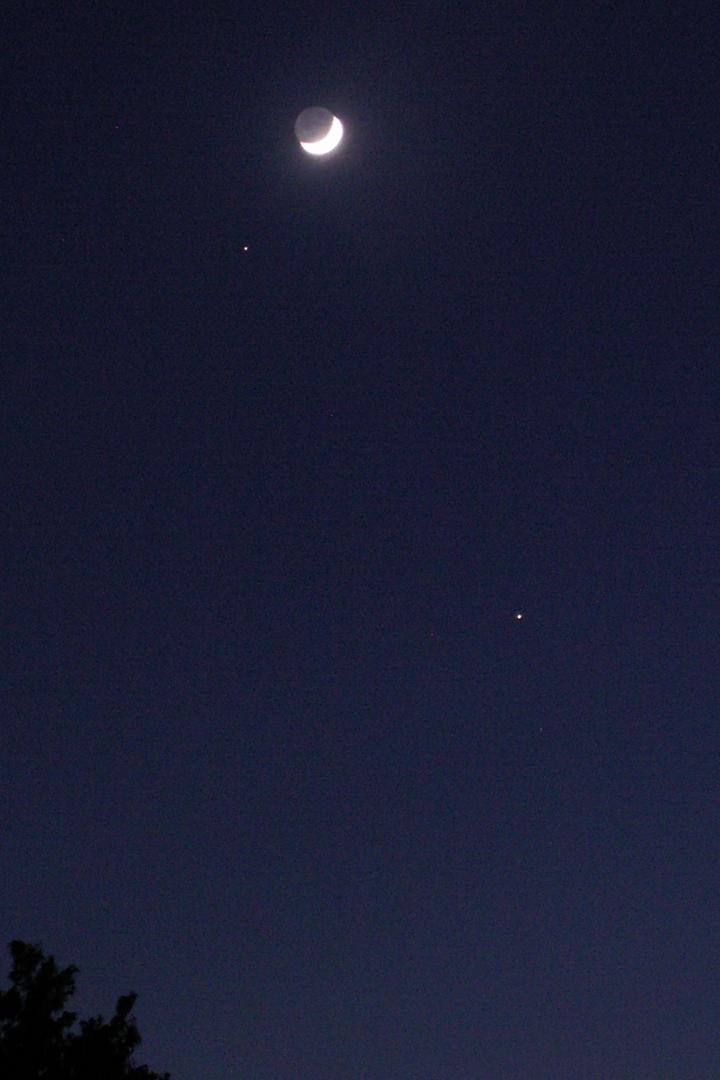
Taken at 9:10:17 PM (EDT) on June 28, using a 4-second exposure at f/3.2. The Moon (11% of full) is visible with Earthshine. The bright dot just to its lower left is Mars. The brighter dot further away just below middle right is Saturn.
At the time I took this photograph, Mercury was further toward the horizon, hidden behind the trees, less than an hour away from setting. Jupiter was climbing toward zenith.
Richard Ellis: "To date, scientists have identified some 450 dinosaur genera based on fossil body parts....Altogether, several thousand dinosaur genera were alive at any one time, which is entirely consistent with estimates for extant mammals, birds, and reptiles."
-- No Turning Back: The Life and Death of Animal Species
450 (let alone several thousand) genera?
That means at least as many and likely many more species.
Ellis adds, "Some dinosaurs had smooth skin and some had scales; some had bumps, horns, frills, spines, or spikes; some had feathers. Some had beaks, and some had a mouthful of huge, serrated teeeth. Some were cold-blooded, like today's reptiles, but some were warm-blooded, like today's birds and mammals."
My own Mesozoic childhood is filled with a thin hardbound picture book and dinosaurs made of forest-green plastic, to the tune of maybe a dozen different creatures. Tyrannosaurus Rex, Brontosaurus (which isn't even called a Brontosaurus any more, but Apatosaurus), Allosaurus, Triceratops (a single dinosaur in my childhood, it now boasts 15 species according to this list, courtesy of the Cape Breton-Victoria Regional School Board in Nova Scotia), Diplodocus, Camptosaurus, Stegosaurus, Ankylosaurus, etc. When I was a kid I thought Ankylosaurus was the coolest thing, kind of a giant armadillo with a club tail.
A limited repertoire of creatures, all looking pretty much like second cousins to Godzilla, hashing it out in a giant jungle amidst belching volcanos.
"Altogether, several thousand dinosaur genera were alive at any one time, which is entirely consistent with estimates for extant mammals, birds, and reptiles." Not a limited repertoire, but an alternate universe. Except it wasn't alternate at all....
The naming is an artificial construct, of course, though one that is (I would presume) naturally hardwired into the brain, human or otherwise. Prairie dogs have been shown to emit different calls at the approach of different individual humans, as reported in the January 6, 2006, Arizona Daily Star. And a May 7, 2006, article in the British Sunday Times presents evidence that dolphins know each other's names and call out their own.
Part of me is like a toddler now, recognizing and calling out to bugs who don't know the names we give them and likely couldn't care less: "Hello, Datana!" Earlier this week I must have seen about half a dozen Datana moths (whose species I still don't know, but at least now I know the genus), hanging out on the mall's brick columns or cement wall. Deliciously weird, tucked tightly into their little wings, looking like miniature and misshapen cigars. Mary calls them "Helmet Heads."
I've got photos now of three different species of Acrolophus moth (I keep mentally hearing it as "Acropolis moth," might do a collage of them peeking out from inside the Greek ruins) that I haven't been able to identify past the genus. Number 2 looks a bit like Acrolophus morus but not quiiiiiiite.... Finding the species name becomes something of a treasure hunt, like guessing Rumplestiltskin's name in order to break a spell.
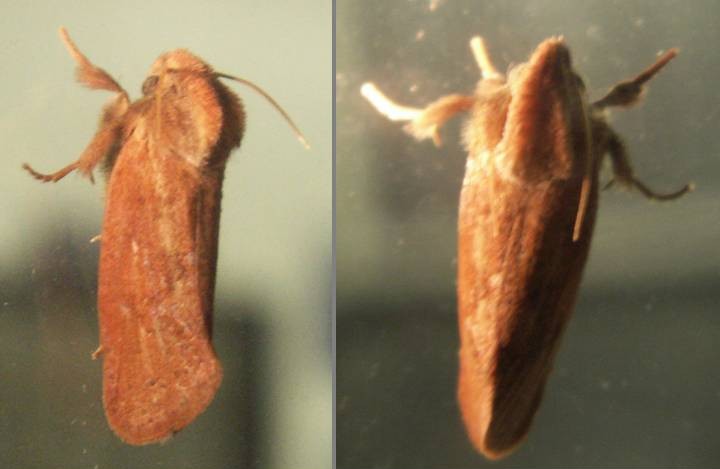
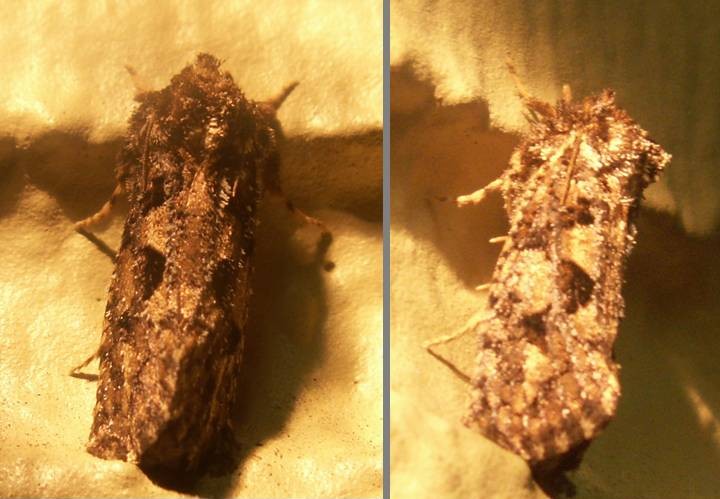
I found #1 on the post office window and #2 at the mall across the street from the PO late Saturday night.
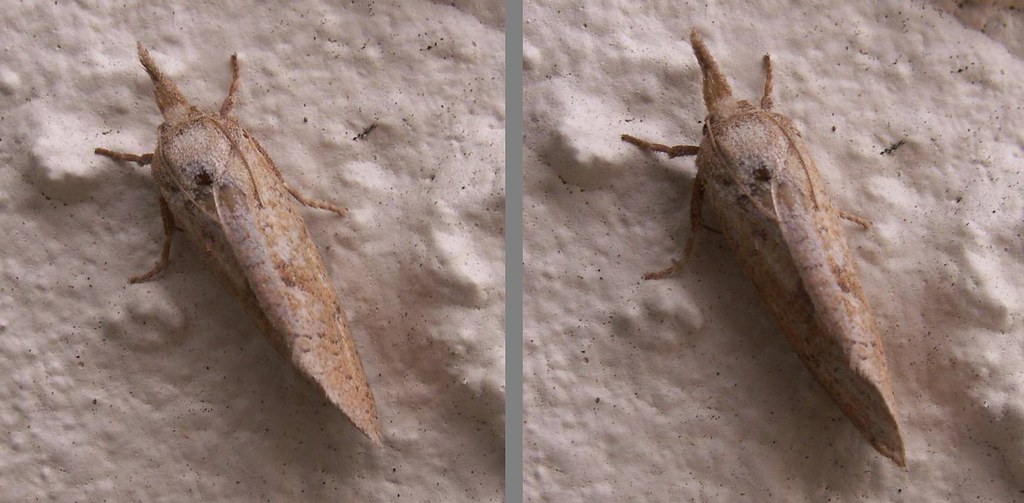
This third moth, which I'd photographed back in May, is likely Acrolophus plumifrontellus. For those who can see stereograms: View with your eyes crossed, relaxing your gaze as you focus on the "center" image to see this moth as 3D.
Thanks to Dennis Profant at Bugguide.Net for the ID on all three. (Profant teaches Entomology, Ornithology, and Dendrology at Hocking College and has been collecting Lepidoptera in Ohio, Florida, and Michigan for 30 years.) These are all Acrolophus (Tubeworm) moths, Family Acrolophidae (Burrowing Webworm Moths); formerly placed in the family Tineidae. Range: southwestern and eastern United States as far north as Pennsylvania and Wisconsin. Larvae feed on soil detritus and the roots of grasses and other plants.
"Labial palps often hairy, and when extended over the head give the moth a furry-headed appearance," according to Bugguide. This is the case with #1 and what I first thought were V-shaped head ridges.
(Insert Sound of Music soundtrack in the background, cued to "Getting to Know You.")
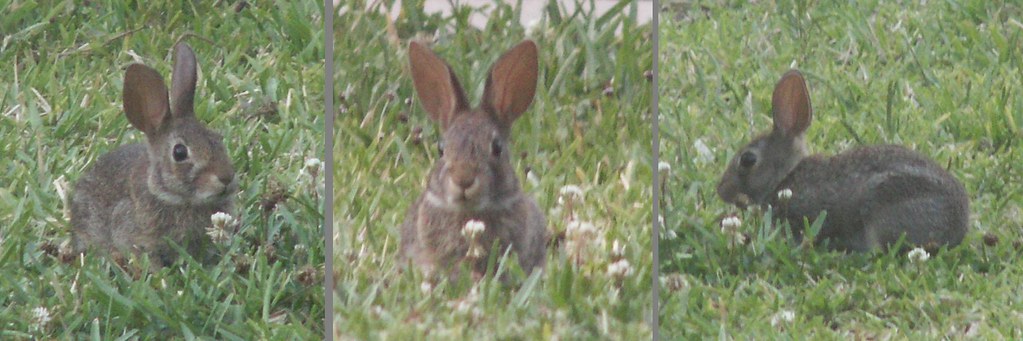
This little guy (gal?) was snacking on the lawn of the recently-built apartment complex we pass on our post office walks. The bunny's expression on the left makes me think of Yousuf Karsh's famous photo of Ernest Hemingway, but that's just me.
Eastern Cottontail, Sylvilagus floridanus, Family Leporidae (Hares and Rabbits). One of two species of rabbit in Florida (the Marsh Rabbit is the other), the Eastern Cottontail also "has the widest distribution of any Sylvilagus. It is found from southern Manitoba and Quebec to Central and northwestern South America. In the contiguous United States, the eastern cottontail ranges from the east to the Great Plains in the west." (University of Michigan Museum of Zoology.) Grass accounts for about 50 percent of the cottontail's diet.
Says the Florida Fish and Wildlife Conservation Commission, "The young are born from March through September after a gestation period of 26 to 30 days. Females may have three to four litters with from four to seven young in a single year. Rabbits nest on the ground and the young are born with eyes closed."
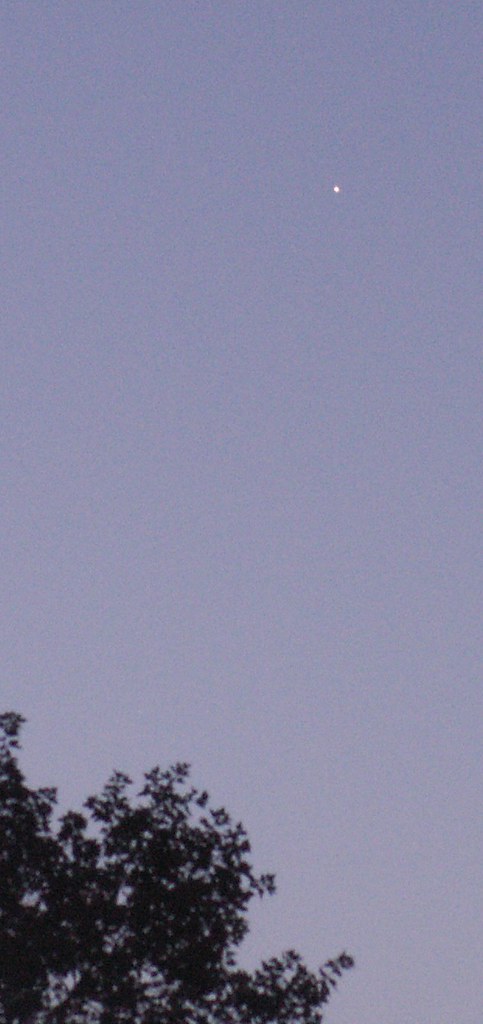
I had gone out to get the newspaper when I noticed Venus in the East. I took this freehand at 6:05 AM (EDT) on June 27, less than a half hour before sunrise for this location. "Through a telescope, it looks like a brilliant white, waning gibbous moon," says Observing the Sky.
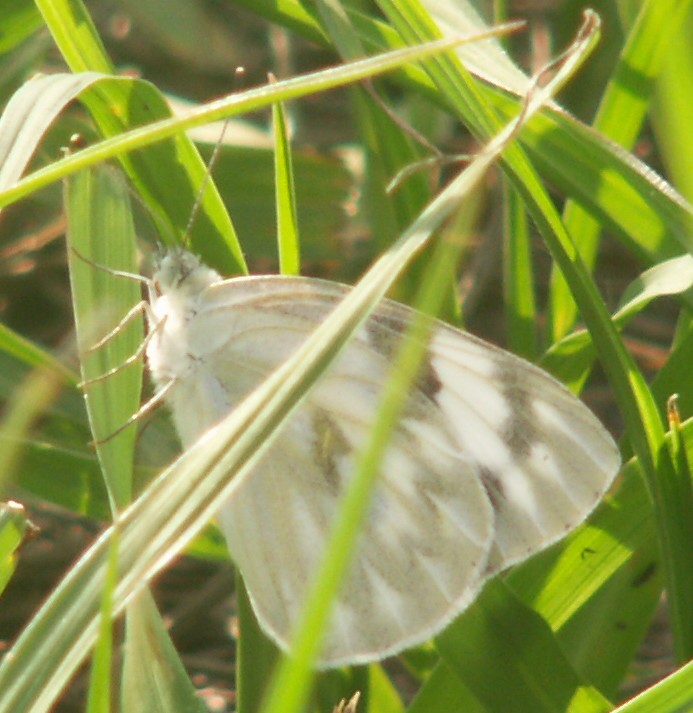
Mary spotted what I believe is a Checkered White (Pontia protodice, Family Pieridae (Whites and Yellows)) by the "post office pond." It remained quite blase as I crouched nearby, moving gradually closer. Mary calls this one the "Victorian Lace Butterfly."
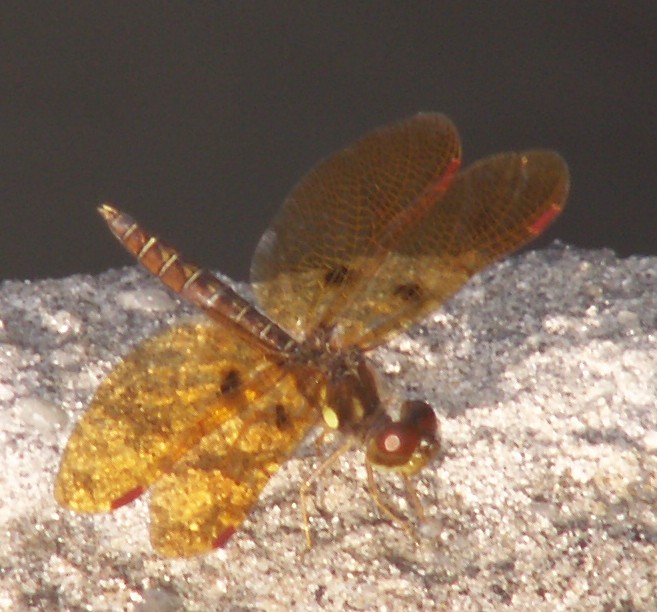
I got clearer shots of these male Eastern Amberwings than I had back on June 20. Perithemis tenera, Family Libellulidae (Common Skimmers). According to Bugguide.Net, "Except along the U.S.-Mexican border, this is the only tiny dragonfly with amber wings on the male." By tiny they mean about a one-inch wingspan. The range of this dragonfly is the eastern two-thirds of the United States and south into Mexico. "Primarily a summer species; active all year in the far southern U.S."

A male Blue Dasher dragonfly (Pachydiplax longipennis) perches on some windswept grass at the "post office pond." More detail is visible in the large view (click the magnifying glass for this and other enlargements).
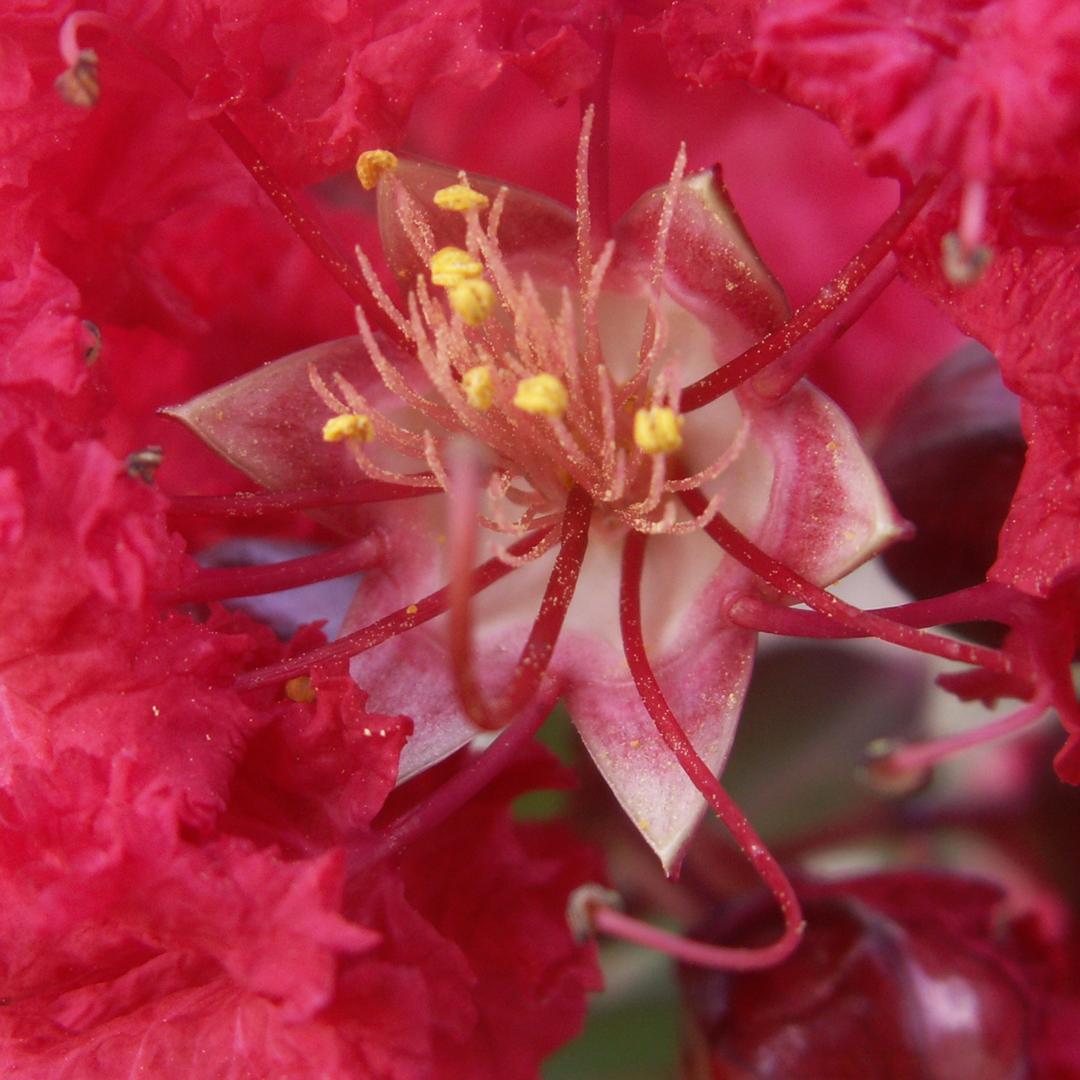
Our crape myrtle trees are finally flowering in earnest. Best viewed large.
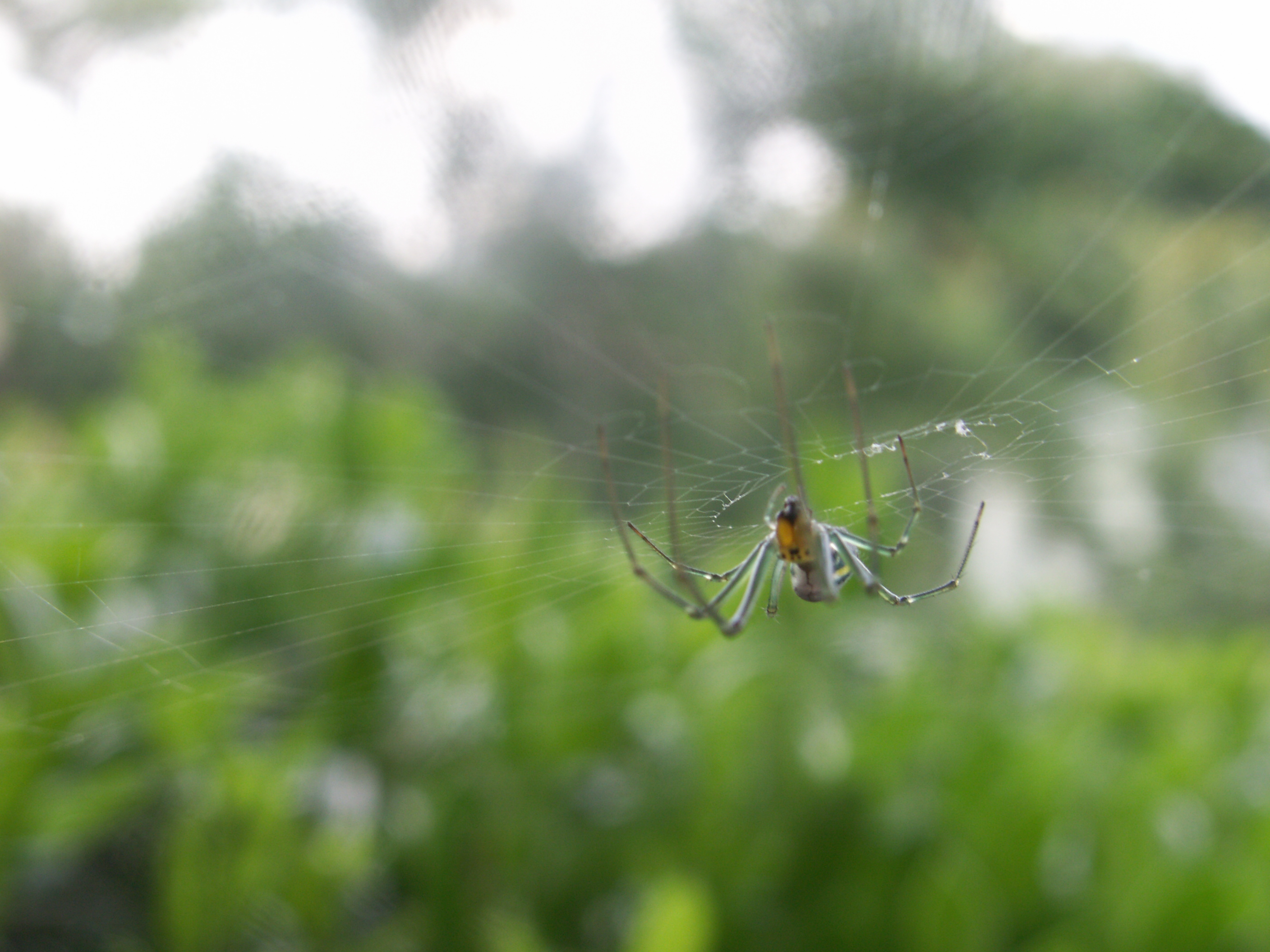
I finally got a shot with good detail of this lovely resident of our front hedge -- and confirmed her Orchard Orbweaver identity by comparing her with volcano's gorgeous shot at Bugguide.Net. Leucauge venusta, Family Tetragnathidae (Longjawed Orb Weavers). "Spins its web at an angle and hangs in the center," according to Bugguide. Our spider's web angle is particularly visible in this shot, taken almost 12 hours earlier when I was photographing Venus.
Non-compressed, as-is out of the camera. View large to greet her eye-to-eye. (A side view is here.)
This species ranges from southern Canada to Panama: "egg mass is attached to leaves and twigs near web; spiderlings disperse and spin own webs."
More to come (including a cattle egret in full breeding coloration, who was moseying around the parking lot outside our local supermarket), after I upload some video at our DSL-enabled library. In the meantime I've got 3 jobs in, which will keep me busy through the weekend. No rush, but I'll be pacing out the days.











2 Comments:
From moonshine to moths to Hemmingway look-alikes to dinosaurs to spiders, a rich offering today indeed! Your interest and excitement at the wonders of our world sings from every line.
Great photo. Ever photograph the moon setting. It happens quick...
Post a Comment
<< Home